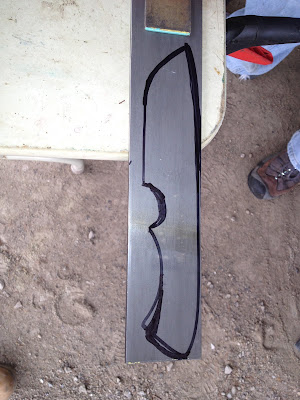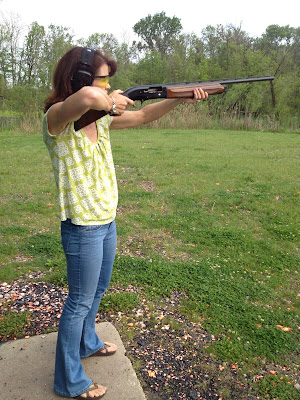May 29, 2012
Washington Post article today
Trap shooter Josh Richmond considers himself a soldier first, and an Olympian second
Josh Richmond didn’t have to ride silently in a convoy, creeping along the outskirts of Kabul, Afghanistan, with unknown explosions occasionally detonating in the distance. He did not have to be separated from his pregnant wife and their 2-year-old son. He did not have to subject himself to war. Someone else would have trained the Afghan natives. Someone else would have done his duty. Richmond could have stayed home.
Except for this: “I’ve got to do it,” he said. “It’s your patriotic duty.”
Richmond is a soldier, and Richmond is an Olympian. That is the order in his mind, and the order in which he wants others to consider him. This summer, he will represent the United States at the London Games, wielding his shotgun as a favorite for a gold medal in double trap shooting. But every day, Richmond represents the United States as a member of the U.S. Army Marksmanship Unit. It is in that capacity that last fall he flew to Kuwait and was bussed to Kabul for three months of training Afghan soldiers in the ins and outs of weaponry.
His identity, then, is clear: Staff Sgt. Joshua Richmond, U.S. Army.
“I’m a soldier who’s also an Olympian,” Richmond said. “I’m a soldier 24 hours a day. Being a good soldier is what’s also helped me become an Olympian. So everything’s kind of around the root of being a soldier, just by the way I’ve trained, the lessons I’ve learned, what it’s taught me.”
‘A professional soldier’
In Richmond’s mind, there is no end to what he has learned since he enlisted in the Army after finishing high school in his tiny home town of Hillsgrove, Pa. That was eight years ago. Now 26, he has spent anywhere from 180 to 200 nights a year on the road, touring with the marksmanship unit, conducting exhibitions in which he and others shoot from behind their heads, from their hips, from all sorts of angles.
They serve, he said, as a connection between “America’s people and America’s Army.” The unit is also responsible for research and development and training. In that capacity, Richmond has been allowed to compete for USA Shooting, just as Glenn Eller, another member of the marksmanship unit and Richmond’s daily training partner, did en route to winning gold in Beijing four years ago.
This is not, in any way, to suggest that Richmond is not a soldier. Because of his international success over the past two years — including winning the world championship in 2010 — he secured his spot on the Olympic team last summer. He then went to both his superiors in the army and his USA Shooting coaches with a plan: Deploy to Afghanistan that fall, abandoning stateside training for three months.
“It absolutely scared me to death,” said Bret Erickson, USA Shooting’s national shotgun coach, a four-time Olympian and former member of the marksmanship unit himself. “Of course, it’s a very safe deployment, and it’s important. But here’s a kid that is No. 1 in the world. He already made the Olympic team. We’re really counting on him to go over there and win us a medal. And it’s like, ‘Oh, crap. What’s going on now?’ ”
What was going on, it turns out, is a sort of cart-before-the-horse line of thinking. Rather than holding him back — while he was overseas, there was no formal way to train — Richmond believed his deployment would enhance his preparation.
“The unit’s accomplishments in raising the proficiency of Afghan soldiers, coalition soldiers and U.S. soldiers are a source of pride for the unit,” said Lt. Col. David Hodne, who commands the group based at Fort Benning, Ga. “For Sgt. Richmond, I think he believed the broadening experience that he would gain would also be a personal source of pride that would also give him a competitive edge at the Olympics. . . . He is the epitome of a professional soldier.”
Richmond’s mission was to join six other instructors and three interpreters near Kabul, training top-of-the-line Afghan soldiers so they could, in turn, train their own men. The initial encounters were awkward, somewhat standoffish. But over days and weeks, the two sides began communicating better, Richmond said. They would train all morning, then sit in the dirt at lunchtime, sharing meals, as important an indication that the Americans had broken through, culturally, as there is.
Richmond worked with roughly 300 men during his stay. When the training began, the Afghans had a 22 percent pass/fail rate. When Richmond and his group left, it was up to 96 percent.
“Marksmanship is a paramount soldier’s skill,” Hodne said. “And marksmanship is the key to an army’s combat readiness.”
Always aware
Richmond believed the work was important, even essential. The mission, though, wasn’t without its tense moments. Explosions would come from what seemed like the distance, but who or what was affected wouldn’t be known until the next day’s news. Rides to and from training grounds were often in silence. Soldiers, even those on the fringes of combat, are always aware.
“You can’t really grasp it till you’re on the ground smelling it, breathing it, eating it,” Richmond said.
So he smelled it, breathed it, ate it. When he returned to the U.S., by his own account, he had changed. There is no direct line to be drawn between serving his country during a war and representing it well in athletics. But he believes he is more suited to winning gold now than before he left.
“Just the mental stability knowing — and the confidence going forward — that, ‘Hey, I deployed to a combat zone; I successfully made it home, and I achieved my mission over there,’” he said. “To have that confidence behind you, it turns you almost into a different person — in a very good way. If you’ve deployed to a combat zone, there’s not a whole lot more out there.”
Since returning from his deployment, Richmond has competed in two World Cup events. He won both, including his most recent, in May in Lonato, Italy, against a field every bit as strong as that he’ll face in London.
“That kind of put away any indecision or fears that he wouldn’t be ready,” Erickson said.
He will be, he believes, even better prepared. When he thinks about those few moments of stepping onto the podium, of hearing the “Star-Spangled Banner” played, he pauses. The tears come quickly. He isn’t just an Olympian.
“How much more patriotic can you get?” Richmond said. “An Olympian wearing the red, white and blue, and oh by the way, he’s an active duty soldier.”
May 24, 2012
1973 French Target Pistol
Came across another nice target gun at the range last night. Its a French made Unique Olympic target pistol, .22. It would have been shot at 25 or 50 meters with iron sights. It has the lightest trigger I've ever shot.
May 23, 2012
That's Venus near the Moon
Nice night out at the gun club but hard to see the targets at dusk. Down another $2. Monday, I shot the Crazy Quail machine. A lot of fun.
May 16, 2012
Shooting
Shot last night at the club, 80 degrees but the wind continues to blow pretty hard out there, as it has for the past few weeks. Struggling through singles for some reason, can't figure out why. Having some more success with 24 yards, settling into some ok scores. Confident enough to start shooting for money, net results so far, -3 Diet Pepsis and -$2. Taking my time, working on my pre-shot routine.
May 14, 2012
Knife Class
Went to a class Saturday and got this knife started.
It begins as a piece of 1095 steel, we drew a pattern on it, cut it out and then ground it to shape.
The teacher showed me how to flat grind it on a 72 inch belt sander. It was harder than I thought.
Then we got all the scratches out of it and heated it cherry red in his forge. Its hot enough when the steel becomes demagnetized. You test it with a magnet attached to the end of a rod. Then the knife comes out and the edge is quenched in an oil bath. That makes the edge hard but the rest of the knife retains flexibiity. He showed me how a file just skips off the blade after the quench. When I got it home, it went for two 2 hour cycles in the oven to temper it. Then I soaked it in muriatic acid to get the scale off.
Now a lot of handwork to get the grinding marks out and work the edge down to something that can be sharpened. Then handle and sheath.
Got some shooting in yesterday. Very windy but it went ok.
May 6, 2012
Date Night at the Gun Club
We went over Saturday night, shot some .22, then low house #7 skeet and some straight aways from the 16 yard line in trap.
May 4, 2012
Colt Woodsman
Took Cal and his friend out to shoot the .22 Friday night. There were a couple of other shooters at the pistol range. One of them had a AR style .22 that he let Cal and Jack shoot, they thought it was pretty cool. Another guy had the above pistol. He had just bought it and tracked the serial number back to 1923, that pistol is almost 90 years old. It was solid, and accurate.
Subscribe to:
Comments (Atom)









